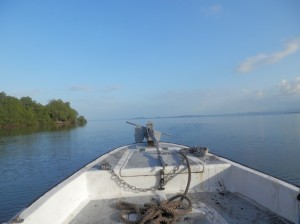In order to understand and appreciate the breadth and importance of the fieldwork carried out by members of the UK Tropical Peatland Working Group, we welcome posts on this blog from anyone with a story to tell. Here, Nick Girkin, a PhD student from the University of Nottingham, describes the fieldwork he carried out last year in the relatively understudied peatlands of Panama.
In January 2016 I started the second stage of my fieldwork in San San Pond Sak wetland in Bocas del Toro Province, Panama. During my first visit in 2015 I trialled a range of fieldwork techniques investigating how below-ground plant inputs, particularly plant roots and root release of exudates and oxygen, can regulate surface greenhouse gas emissions and the extent to which this differs between plants of contrasting physiologies (i.e. palms vs broadleaved evergreen trees). This time I had developed a range of experimental approaches including plans for in situ mesocosms to exclude roots and root inputs, phloem labelling with natural abundance and 13C labels and a 13CO2 labelling experiment. The results of this work are important in terms of broadening our understanding of how regulation of greenhouse gas emissions may differ between different plant groups, with implications across forested peatland ecosystems.

Access to San San Pond Sak Wetland
The site itself is dominated by two plant species: Campnosperma panamensis, a broadleaved evergreen tree, and Raphia taedigera, a palm, and I aimed to assess whether differences in greenhouse gas fluxes between these species previously observed could be linked to differences in below ground release of root exudates, oxygen and decaying root material.
During both field campaigns I was based at the Smithsonian Tropical Research Institute research station on Isla Colon, a short boat ride away from my field sites on the mainland. On sampling days I, together with Erick Brown my field guide, would take a boat across the short stretch of the Caribbean to reach the wetland, before a short 1 km trek through the swamp forest to the field sites. The first week was particularly long and laborious, involving clearing a trail to the field site, making and then installing mesocosms into the soil. The average day of fieldwork involved collecting surface gas samples from the mesocosms and measuring a range of soil properties known to regulate gas fluxes (e.g. the height of the water table). CO2 and CH4 fluxes from these sites broadly match those measured in South East Asian Peatlands (400 – 800 mg CO2 m2 h-1 and 0.1 – 2 mg CH4 m2 h-1).
Work at the station involved tending to transplanted Campnosperma, Raphia and Symphonia globulifera saplings which towards the end of my fieldwork I labelled with 13CO2 with the aim of tracing recent photoassimilates into plant tissues, the soil microbial community and the production of CH4 through microbial use of plant derived carbon.

Reaching field sites in San San Pond Sak